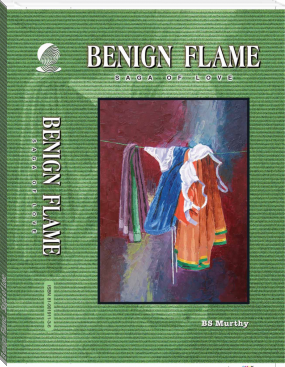Jewel-less Crown: Saga of Life by BS Murthy (novels for teenagers .TXT) 📖

- Author: BS Murthy
Book online «Jewel-less Crown: Saga of Life by BS Murthy (novels for teenagers .TXT) 📖». Author BS Murthy
Upanishadic Theory of Evolution
One such theory of evolution in the Brihadaranyaka Upanishad reads thus—’He had no pleasure either: so when alone one has no pleasure. He desired a companion. He became as large as a woman and man embracing. He made that self split (pat-) into two: from that husband (‘pati’) and wife (‘patni’) came to be. ‘She realised: ‘How can he couple with me when he begot me from himself? Ah, I must hide!’ She became a cow, the other a bull, and so he coupled with her. From that cattle were born. She became a mare, the other a stallion; she became a she-donkey, the other a he-donkey: and so he coupled with her. From that solid-hoofed animals were born…’ (Excerpted from, The Upanishads, by Valerie J. Roebuck published by Penguin Books India). This could as well be man’s first thesis on evolution.
Western Theory of Evolution
Well, Spencer, Lamarck, Darwin and others of our times could have breached the religious idea of creation with the collective force of pure reasoning. But would their standard of evolution thus erected on the land of religion stand up to logic? After all, the three millennia or more of anthropological data that modern man is in possession fails to indicate an iota of variation in the existing species not to speak of the evolution of the new! That being the case, could it be then the world came into being on its own, as it were! Well if it were so, the question that arises is, wouldn’t have the first men made their progeny privy to that story? But that didn’t happen either, as we don’t even have hearsay to go by about our origins. Besides, the religious routes of creation shown by the later generations all led us into blind alleys. Thus, far removed from our beginnings, we had to figure it out ourselves as to how we came into being. After all, it’s that quest for his origins that lead men to the theories of evolution. Nevertheless, won’t that be like putting the cart before the horse, for the earth is the only planet known to nourish life? Would it not be imperative to try to assess whether the way the earth itself came into being would have had a bearing on the evolution of its species?
Addendum to Evolution
It would seem there could be but mere space in the beginning—infinite and empty. At some stage, its gathering cosmic charge, having become boundless, would have disintegrated into an infinite number of nebulous stars of vast proportions. Needless to say, these stars, in spite of being nebulous, would have acquired a definitive magnetic moment of immense intensity of their own. And the attendant magnetic field could have kept the residual cosmic charge around them at bay. In time, the interplay of magnetic moments would have fragmented the residual nebulous energy around these stars into their planets. In the end, it could be the powerful magnetic thrust the stars would have exerted on each other, that caused their cosmic drift along with their planetary formations in tow.
It was in that altered station, far removed from the cosmic bosom that an intense centripetal force would have come to exert on the sun and its planets in their nebulous state. Over the years, this phenomenon would have tended to compact their nebulous energy into spherical formations. This, in turn, would have brought to bear the centrifugal forces on the sun and its planets that tended them to shed some of their heat energy. That, in turn, would have occasioned the peripheral cooling of the planets. In time, all the expelled nebulous heat would have galvanized itself as the moon to turn into the satellite of the earth. It would appear that the concept of astrology could be but the appreciation of this cosmic phenomenon.
Be that as it may, where to begin to find out what could have helped the mother earth to bring beings into being? Well, wouldn’t it be in order to assume that the spread-split-steady syndrome that was behind the formation of the solar system would have been at work in the evolution of the species as well? Would not the procreative process, the feature of the perpetuation of the species subscribe to this? Of course, since neither custom stales nor age alters the procreative process of the species, we might reckon that it is in that process must lay the clues to the origins of beings.
Well, the world in its beginnings would have been but a wilderness of earth, water and air—the gross elements of nature—that would have been evolved owing to the altered cosmic equations. The day and night phenomenon on the earth would have perpetually subjected these elements to some annealing stress—while days would have warmed them by the sunrays, nights could have gripped them in their cold embrace. However, the landmass, once it got solidified to some depth, would have rested on its laurels but for the jerk of an earthquake or a jolt by a volcano. On the other hand, air and water, given their volatile state, would have been perpetually stressed and strained by the day-night syndrome. Thus, the constant impingement of heat and cold on air and water, both containing oxygen and hydrogen, would have come to impact upon the chemistry of them both in the climatic laboratory. In the end, it would have been the atmospheric disturbances like cyclones and hurricanes that would have brought about the fusion between the much-strained water molecules and the turbulent atoms of the air.
Onamic Formation
The outcome of this fusion could have altered the molecular structure of countless water particles in a way to originate the organisms – O, that we might call onams. As the seas played the mother to this earthly union, onams could have embraced their waters, though in time many might have made their way into the sister rivers as well. But the cyclonic and such atmospheric convulsions that fathered them would have been ever tending many of them into the atmosphere. Likewise, the ocean tides and the flooding rivers would have displaced many an onam onto the ground around. Anyway, it did not hurt them. Being fundamental organisms, the onams would have been unicellular in construct and microscopic in size, without a digestive mechanism of note. Besides, their micro construct would have only needed a minuscule diet for self-sustenance. Thus irrespective of their station they would have come to survive on their self-secretions in a unitary and conflict-free environment. That was how the onams would have come into being and came to exist as such. Thus, we might reckon that the instinct of the species to prey upon their fellow species would have certainly been a non-onamic character.
Having thus emerged from the nebulous state of non-being, the onamic state of being would have been one of stagnant being. However, as nature could have caused more and more of them to come into being, in time, there could have been the onamic clusters in their trillions all over. At some stage, nature itself might have come to grips with its own waywardness, exemplified by the regulation of the seasons. And all that would have changed the character of the prevailing environment itself, affecting the climatic conditions conducive for furthering the onamic generation. As nature would have ceased to occasion their propagation, the onams could have been compelled to self-generate so as to remain in being. This could as well be the harbinger of the evolutionary process that could have led to the emergence of the species.
But how come the unicellular onams could have multiplied into a wide variety of multi-cellular species? And then, wherefrom did the plant life emerge? Well, the ebbs would have retrieved into the high seas some onams that the tides could have washed ashore. Likewise, the receding river waters would have salvaged some of its onams from the riverbanks that the floods inundated. This great escape would have exposed such of those water onams to an amphibious experience of being. Nonetheless, owing to this recurring phenomenon, many in their millions would have been periodically left stranded in the unfamiliar environs of the beachheads and riverbanks. In time, the stimuli of their clustered existence would have induced in the onams of the world the instinct to spread. This, in turn, would have imbibed in them the urge to split. The very instinct for the individual spread would have insensibly led to the collective onamic surge. Needless to stress, this could have been achieved with each yielding space to the other in order to gain the same for the stability of the self. This could well be the harbinger of life on earth, though in its rudimentary form. What is more, this characteristic of yielding to gain seems to have shaped the nature of beings during their evolutionary period and beyond. However, with their imbibed instinct to stay in the air, the atmospheric onams would have had free access to the world at large and thus would have been less urged to spread. Thus, the atmospheric onams would not have come to feel the need to split at that stage.
As the earthly onams began to gain in size, they would have needed extra secretions for sustenance that the system was unaccustomed to generate. Besides, their state of growth would have undermined the onamic sense of safety their unicellular compactness provided. Understandably, all this would have ensured that the systemic pulls and pressures came to bear upon the onamic growth. This, in turn, could have forced their survival instinct to cap further growth. Thus, at that state of growth, there could have been a duality of purpose in the enlarged onamic organisms—the acquired habit to grow in order to gain and the innate need to remain small so as to survive.
Plunamic Progression
Naturally, this clash of interests would have induced fission in the system that could have lead to the eventual rupture of the mechanism itself. It was thus, the onams could have split into two and that would have ushered in the second stage of evolution. Understandably, the coming into being of two organisms—plunams—in place of one, would have enabled the agenda of unrestrained onamic growth. Dictated by the inherited urge, the plunams would have pursued the old onamic agenda of growth till the need arose for yet another plunamic parting of ways. This phenomenon of onamic split would have in time led to the plunamic proliferation of exponential proportions on the ground as well as in waters. In the process, though being unicellular, the plunams would have begun to experience a vague sense of biological difference amongst them. However, the atmospheric onams would have been some way away from the plunamic state of evolution on the earth.
Nonetheless, it appears, in spite of the plunamic evolution, the onamic urge for surge remained unsullied. And abetted by habit, it would have indeed turned into a plunamic obsession. In turn, all this might have enabled the plunamic organisms to gain some sense of memory. It is but natural that the urge to grow and the need to split would have impacted on the plunamic memory to impart a sense of separation to it. Thus, it could have been only time before the plunams would have seen
 Reading books romantic stories you will plunge into the world of feelings and love. Most of the time the story ends happily. Very interesting and informative to read books historical romance novels to feel the atmosphere of that time.
Reading books romantic stories you will plunge into the world of feelings and love. Most of the time the story ends happily. Very interesting and informative to read books historical romance novels to feel the atmosphere of that time.




Comments (0)